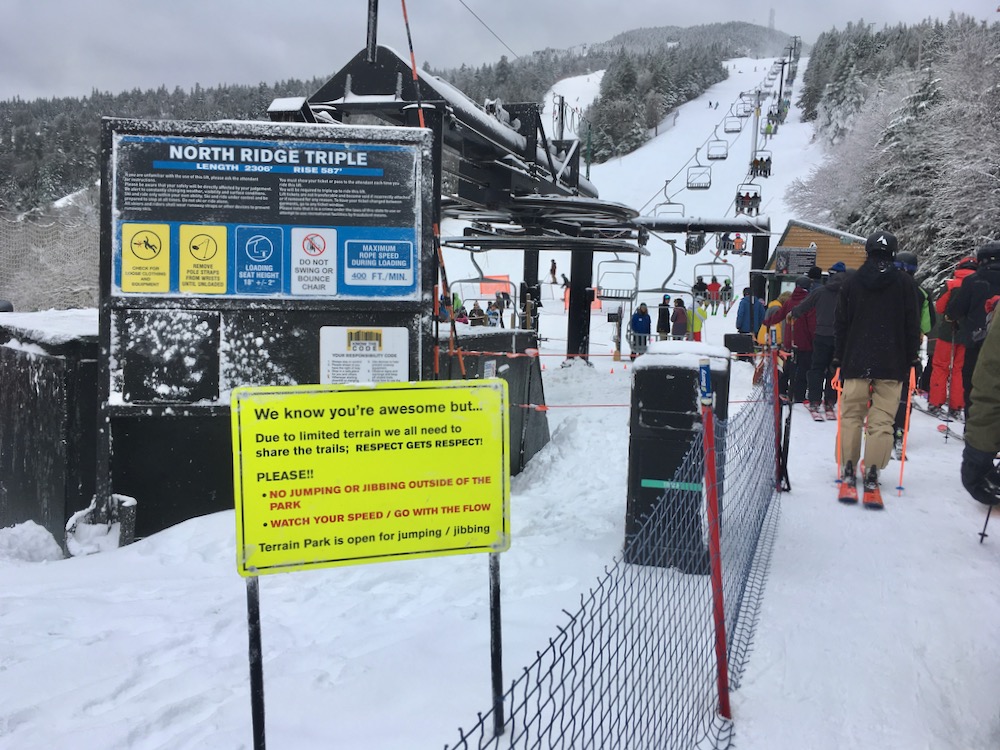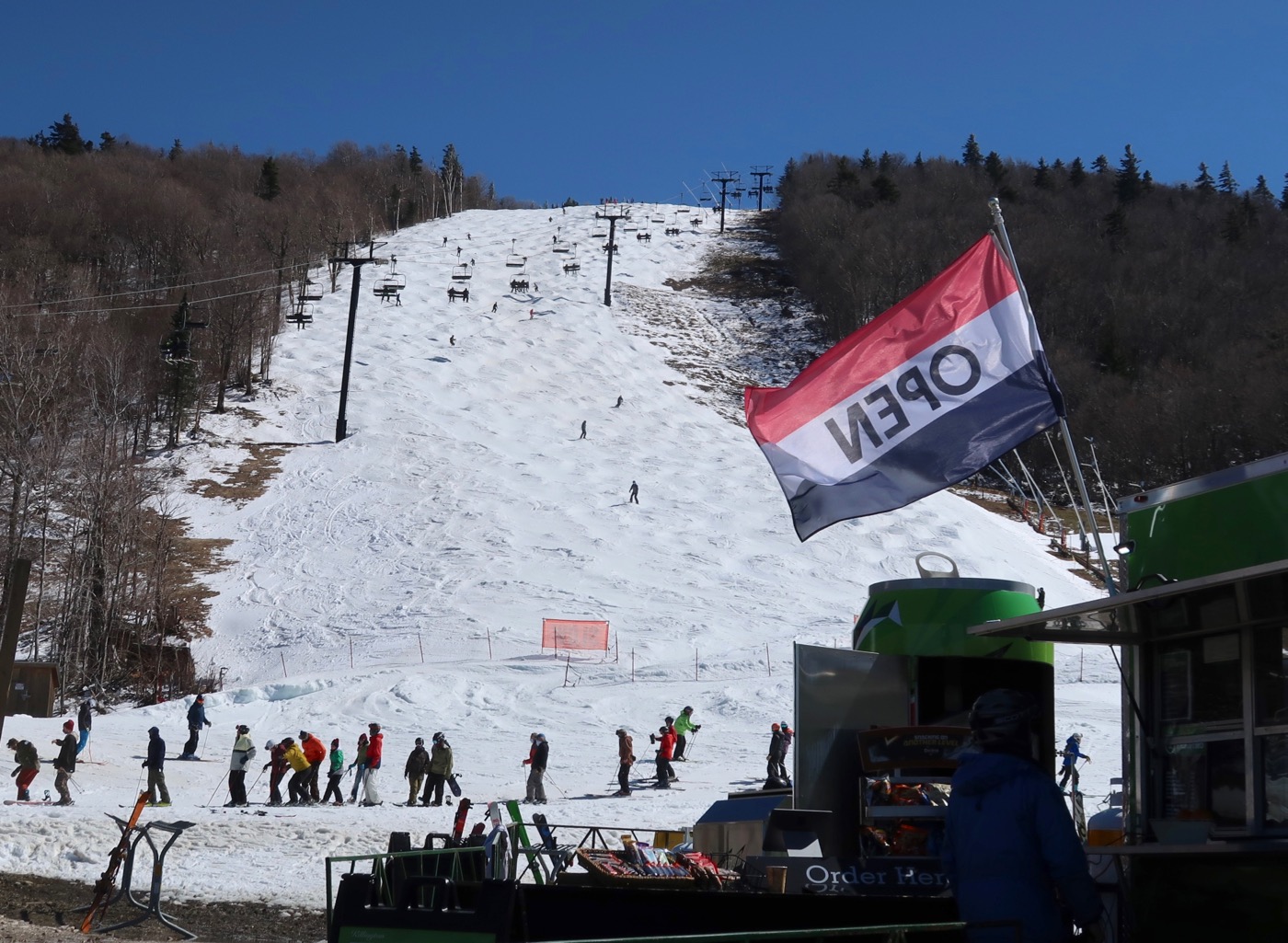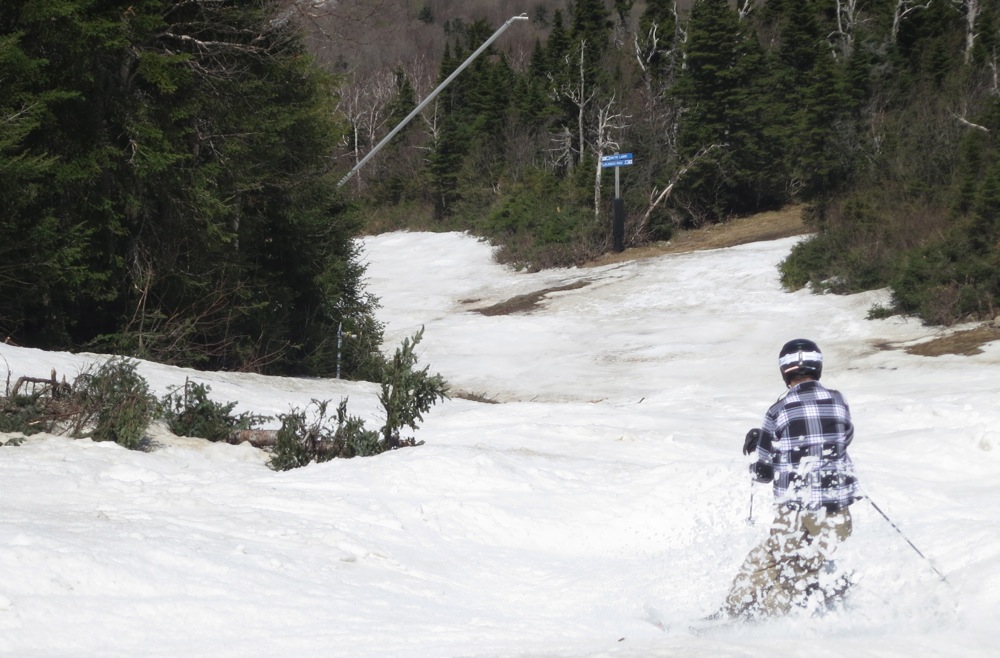Killington is a big resort. It’s got everything that label implies; hotels, condos, detachable lifts, fancy restaurants. It’s owned by a large corporation, Powdr, that exists to make money. In that respect it’s like all the other big commercialized ski resorts in Vermont — Okemo, Stratton or Mt Snow. Still, somehow, Killington always felt different.
Killington has so much terrain, tons of tree skiing and lots of nooks and crannies, you can get lost and pretend you’re not at the biggest ski resort on the east coast. Killington hosts the World Cup and the Bear Mountain Mogul Challenge and one of the best party scenes in Vermont. It opens earliest and closes last almost every winter. Sometimes Killington makes it to June 1st, which can’t possibly make economic sense.
We like to imagine that within Killington operations there is some sort of institutional memory, a recognition and belief that the place is special. We like to believe that the people running the show love skiing as much as we do. We want to think that Killington appreciates the fanatics who sleep in their cars to ski two trails in October. Killington serves a large and diverse customer base, that includes a variety of big spenders, locals, kooks and dirtbags. From what we’ve seen in the past, they seem to value them all. Are we projecting all of this?
It’s disappointing to see Killington embrace a fast-pass style product like Disneyland or Six Flags. For $49, or more if demand dictates, you can load the lift through an exclusive and shorter line.

There are those who think it won’t be so bad, and not that many people will take advantage of it. Most of this kind of thinking is focused on the extra time it will take for regular ticket holders to get on a lift. It’s that extra time, it is theorized, that won’t be so bad.
Will there be effects beyond that? Will skiing feel any different? No matter “how well you know the mountain” you’re going to end up at a crowded mountain base area at some point in your season. Will that hectic experience actually be any different if a sponsored minority moves in and out quickly, while you wait?
Corporations have to make money and there’s no doubt that multi-mountain pass products have cut into margins. If the Ikon pass is a loss-leader designed to get customers through the door, Fast Tracks are the expensive and tempting purchases displayed next to the cash register.
There has always been an element of elitism in skiing, as so many internet skiers constantly remind us. Maybe it was just a matter of time before a velvet rope was used to further divide us into more efficient revenue streams.
The insult on injury — one of the first places protestors have gone — is the fact that this was all done after the pass deadline. We sold your our best, premium product, and after you bought it we added another product that was even better. We agree this doesn’t feel right. After a largely negative reaction from skiers Powdr walked that back, or maybe called that bluff, offering full pass refunds to anyone who wants out. It will be interesting to see if anyone takes advantage.
We’re probably not telling you anything you don’t already know, the outrage on this is already well documented. We’re disappointed in this move by Powdr, but we still love Killington and we’re not going to stop skiing at Big K. It remains to be seen how the average skier will respond this year, and next year at the pass deadine.



I am torn, Ski areas need money. I knew a lot about Mount Snow’s viability in the 90’s and many years the golf courses generated as much profit [not revenue] as skiing. If the cheaper season passes are money losers, revenue needs to be made somewhere else. Obviously the “fast pass” is only a realistic buy on the weekend and holidays. Seems elitist, but on the other hand Eastern Skiing is dependent on snowmaking which is way expensive, and without decent snow no one will enjoy the mountain.
Don’t ski on a Saturday.
It’s hard to walk away from a mountain you’ve skied at for years or have a home nearby but there are options. Epic and Ikon passes are really putting pressure on these companies so I’m not surprised Powdr is doing this. It seems like a not very well thought out policy, the execution is very disappointing. The concept really adds to the idea that skiing is an elitist sport.
I can’t imagine the Ikon and Epic mountains will look to add something like this, Vail seems to have a great recipe with their Epic pricing. My worry is that it spreads to Ski3 or other “smaller” mountains.
I don’t see this policy helping out with lift lines or easing any congestion. Quiet the opposite.
“I can’t imagine the Ikon and Epic mountains will look to add something like this, Vail seems to have a great recipe with their Epic pricing. My worry is that it spreads to Ski3 or other “smaller” mountains.”
Vail charges nearly forty dollars to park at Vail, eliminated free parking at Beaver Creek, and now are starting a new premium parking fee structure at Mt. Snow. To say that Vail Inc. is concerned with affordability for the average skier is silly. Try buying a burger at one of their mid mountain lodges.
Benny, I didn’t mean claim that Vail has any concerns like that. They are without a doubt trying to maximize their profits. The cost of a day pass at any of their resorts is insane and like you said, parking and food are not much better. I was more showing how Epic pass pricing has put a lot of pressure on non Epic mountains to come up with ideas to compete. Hopefully more thoughtful ideas than this Powdr fast pass will be next.
Like continued massive snowmaking and late season grooming, diligent lift maintenance, and a new base lodge? I’m all for that.
No doubt, there will be some justified complaints lodged by skiers in line, who recognize they are being lapped by fast track pass holders. Change is the true constant, but in the paving over of the past, what often seems to be getting lost is the value of individuality. I was very fortunate to have started my life long skiing career, thanks to my father, around 1960, in Massachusetts. This time period was the true boom and growth era of skiing in the Northeast, the 60s. Back then, it seemed to snow, and hold snow, enough from early December to early March, to fuel local interest for outdoor sports. Local ski operations were numerous, rope tows and occasional T bars serving skiers. A few areas would advance to snowmaking capability, and they were the bellwethers of a region. Small or large, ski areas usually originated from the vision of an individual operator, or a small group of investors. They were invariably avid skiers, no doubt hoping the project would at least pay for itself. This was also true in the origins of the large ski resorts that exist in Northern New England today.
Modern economies of scale have forced an undeniable need for change in these business models. The image of skiing as an expensive sport, which it is, adding layers of apparent elitism, runs contrary to goals of inclusion and diversity, be it economic, geographic, or racial, which we are all hoping to progress. I respect businesses doing what they feel they have to do, but I also encourage the independent operations to carry on and be supported by the media, the industry, and skiers. Let’s share this great sport.
Think of all those waiting in line for their exit on the highway and there’s the few who go all the way to the end and force their way in. Basically the same principle here they are just paying to do it. So hear me now and believe me later… you ski up next to me in a fast pass line you’ll be heckled like there’s no tomorrow.
I slept in my car once to ski there on October 4th. Thanks for the flashback. Fast Track? Hell No! My Wobbly Barn dancing days were a long time ago. If I ever return I will happily buy the Slow Pass and take the uphill route.
Rick Payer really hit the nail on the head. When skiing blossomed in the early 60’s there was usually decent snow from Thanksgiving to late March pretty much from Albany North. The Cats , Poconos and Jersey also had far more consistent cold weather for the nascent snow making. When I first bought property at Pico around 1990, the warnings about global warming were just coming out. Doing due diligence I checked some of the studies and I must say that the predictions and models from back then are all coming true. I wasn’t so worried about the buying the property because 30 years in the future seemed like a long time. Oh the ignorance of my early middle age. I can only say that the young people here better get political and loud, because the winters are different and continuing to change. Skiing of course is recreation but in some respects it’s one of the canaries in the coal mine of out environment. If nothing is done soon many things will change including Eastern Skiing.
Right on NYSkiBlog and all of you who commented. You were smart to buy at Pico in the 90’s, jimmypete. And Rick Payer, you laid the facts out clean and cold. I was looking at moving to the Rutland area last year, but I’m starting to think I’ll just stay right here in Western New York and still ski at my independent mountain, Bristol. I’ll still visit Killington and Pico, but it’s starting to look like it’s just not worth it for all the above reasons all of you mentioned.
Is Pico doing this as well?
I don’t believe Pico is part of this.
Rick’s comment really speaks to me too. There’s a job for you here on the editorial page, Rick.
Thanks, Harvey, I would love to contribute.
Rick Payer
I think people are neglecting the fact that 2% of skiers are going to be offered the opportunity. When K has 20k skiers I don’t believe 400 people are going to effect anyone’s experience. I’ll take a wait and see approach. I also believe people are making a big to do out of nothing.
Other areas have tried this and it fizzled. Stratton comes to mind. Like Tim says, better to take a wait and see approach.
I hope ORDA doesn’t read this article.
Having turned 80 this year, I’m about to enjoy a $59 Killington season pass. I’m told it used to be free for 80+, but $59 is chump change for what it offers.
The $229 (70+) season pass from ORDA isn’t bad, either, but it pales in comparison to the above.
Just curious, how is this different from the commonplace interstate express lanes that are pay to use for what are usually lower congestion roads?